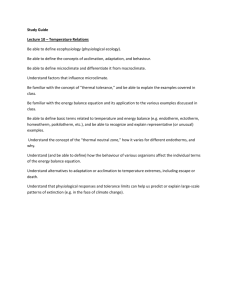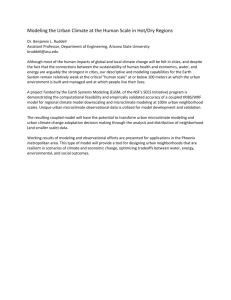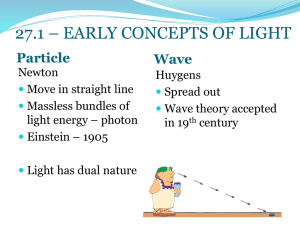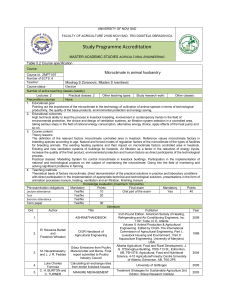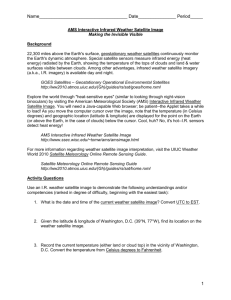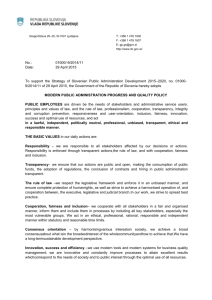Ch02TBAns
advertisement
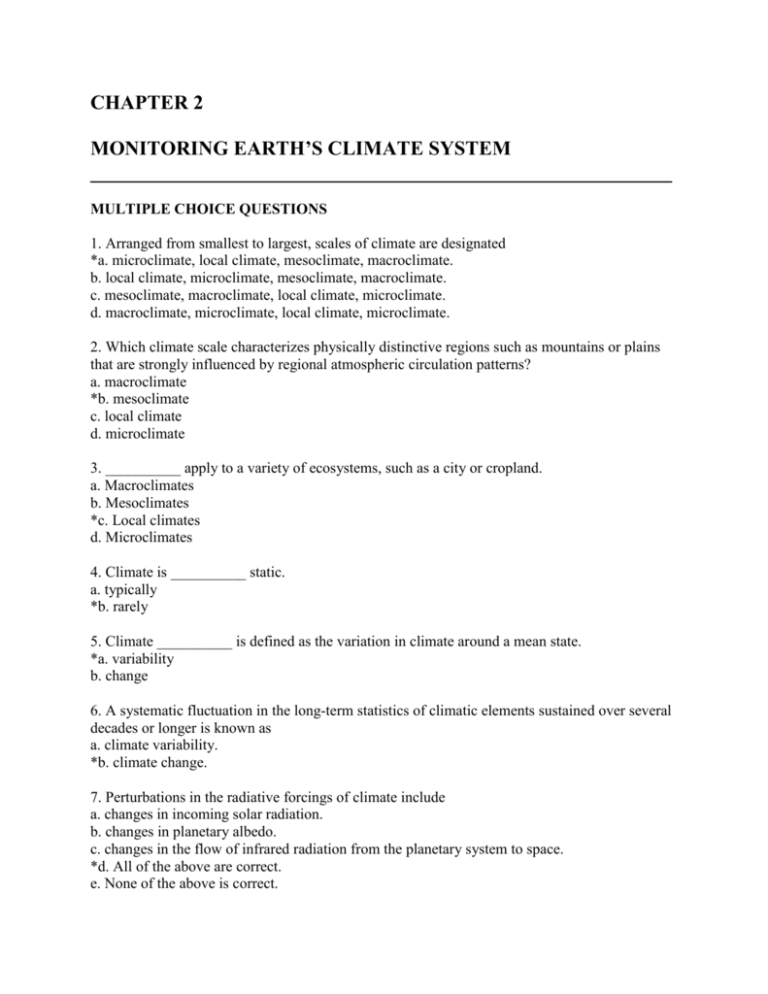
CHAPTER 2 MONITORING EARTH’S CLIMATE SYSTEM __________________________________________________________ MULTIPLE CHOICE QUESTIONS 1. Arranged from smallest to largest, scales of climate are designated *a. microclimate, local climate, mesoclimate, macroclimate. b. local climate, microclimate, mesoclimate, macroclimate. c. mesoclimate, macroclimate, local climate, microclimate. d. macroclimate, microclimate, local climate, microclimate. 2. Which climate scale characterizes physically distinctive regions such as mountains or plains that are strongly influenced by regional atmospheric circulation patterns? a. macroclimate *b. mesoclimate c. local climate d. microclimate 3. __________ apply to a variety of ecosystems, such as a city or cropland. a. Macroclimates b. Mesoclimates *c. Local climates d. Microclimates 4. Climate is __________ static. a. typically *b. rarely 5. Climate __________ is defined as the variation in climate around a mean state. *a. variability b. change 6. A systematic fluctuation in the long-term statistics of climatic elements sustained over several decades or longer is known as a. climate variability. *b. climate change. 7. Perturbations in the radiative forcings of climate include a. changes in incoming solar radiation. b. changes in planetary albedo. c. changes in the flow of infrared radiation from the planetary system to space. *d. All of the above are correct. e. None of the above is correct. 8. Over a broad geographical region, climate anomalies __________ occur with the same sign or magnitude everywhere. a. do *b. do not 9. An average temperature below the long-term average would be a __________ anomaly. a. positive *b. negative 0 10. The geographic __________ of climatic anomalies is key to agroclimatic compensation. a. uniformity *b. non-uniformity 11. Considering the characteristics of westerly waves, a single weather extreme __________ encompasses an area as large as the United States. *a. never b. occasionally c. typically d. always 12. Clouds have __________ effects on the lower atmosphere. a. only cooling *b. both cooling and warming c. only warming 13. A positive feedback loop __________ fluctuations in climate. *a. amplifies b. weakens 14. The ocean is a major sink for a. carbon. b. heat energy. *c. Both of the above are correct. d. None is above is correct. 15. The __________ point is the threshold in a dynamic system when a new or irreversible development occurs. a. in situ *b. tipping c. feedback d. climatic 16. A radiosonde measurement of atmospheric temperature is an example of *a. an in situ measurement. b. remote sensing. 17. A rawinsonde monitors a. temperature. b. air pressure. c. dewpoint. d. wind direction and speed. *e. All of the above are correct. 18. A dropwindsonde provides vertical profiles of temperature, pressure, dewpoint, and wind while __________ in the atmosphere. a. ascending *b. descending 19. Acoustic thermometry uses sound to create profiles of seawater a. pressure. b. salinity. *c. temperature. 20. Argo is an array of *a. profiling floats. b. dropwindsondes. c. rawinsondes. d. satellites. 21. Satellite sensors monitor a. the atmosphere. b. surface ocean waters. c. deep ocean waters. *d. Only a and b are correct. e. Only a and c are correct. 22. Infrared radiation has __________ wavelengths than visible light. a. shorter *b. longer 23. Wave frequency is __________ proportional to wavelength. a. directly *b. inversely 24. What type of satellite moves in a nearly north/south orbit, passing close to the poles? a. GOES *b. POES 25. The clear atmosphere is essentially __________ to visible light and __________ infrared radiation. a. non transparent…..selectively transparent to *b. transparent…..selectively transparent to c. non transparent …..transparent to all wavelengths of d. transparent….. transparent to all wavelengths of 26. Which type of satellite image is available 24 hours a day? a. visible *b. infrared c. Both of the above are correct. 27. Water vapor satellite imagery displays water vapor concentration a. in the troposphere within 1000 m of the Earth’s surface. *b. in the troposphere between altitudes of 5000 to 12,000 m. c. above altitudes of 25,000 m. 28. Radar instruments mounted on satellites are __________ sensors. *a. active b. passive 29. Which satellite in NASA’s Earth Observing System focuses on measuring ocean surface topography? a. CloudSat b. CALIPSO *c. Jason 2 30. NASA’s ICESat satellite monitors ice sheets in a. the Northern Hemisphere only. b. the Southern Hemisphere only. *c. both the Northern and Southern Hemispheres. 31. The mission of GEOSS is to a. continually monitor and measure Earth’s environment. b. link together observation systems in compatible formats. c. provide a free and open exchange of information between participating nations. *d. All of the above are correct. e. None of the above is correct. 32. The __________ is charged with evaluating the state of climate science as the basis for policy action. *a. IPCC b. GEOSS c. NCEP d. NASA 33. The IPCC includes more than 2000 scientists from a. the United States alone. b. only the United States and Europe. c. only the United States and Canada. *d. over 150 nations. e. every nation in the world. 34. In 2007, the IPCC concluded that global warming since the mid-20th century was __________ caused mostly by human activities. a. not likely b. somewhat likely c. likely *d. very likely 35. Which type of model is forefront in performing complex investigations of the climate system? a. conceptual b. graphical c. physical *d. numerical 36. A map with plotted values of temperature and pressure is an example of a a. conceptual model. *b. graphical model. c. physical model. 37. __________ climate models are most likely to predict climate variability, whereas __________ models predict climate change. *a. Empirical…..dynamical b. Dynamical…..empirical 38. In the United States, numerical weather and climate forecasting is the responsibility of *a. NOAA/NCEP. b. NASA. c. EPA. d. USGS. 39. Forecasters at the Climate Prediction Center prepare __________ climate outlooks. a. 30-day (monthly) b. 90-day (seasonal) c. multi-seasonal *d. All of the above are correct. e. Only a and b are correct. 40. A successful forecast of the prevailing circulation pattern at the __________-mb level of the atmosphere is key to predicting monthly temperature and precipitation anomalies. a. 100 b. 300 c. 500 *d. 700 e. 1000 41. __________-day climate outlooks rely heavily on long-term trends and recurring events. a. 30 *b. 90 42. A suite of __________ NCEP Global Climate Model runs yield a mean prediction. a. 2 *b. 20 c. 200 43. A global climate model differs from a numerical weather forecasting model in that it a. predicts broad regions of expected temperature and precipitation anomalies. b. predicts the mean location of atmospheric circulation features. c. provides a more exact placement of high and low pressure centers. d. All of the above are correct. *e. Only a and b are correct. 44. In a __________ global climate model run, carbon dioxide is slowly added to the model and the effects are continuously evaluated. *a. transient b. equilibrium 45. Global climate models __________ been used to predict climates of the geologic past. *a. have b. have not 46. The magnitude of global temperature change tends to __________ with increasing latitude. a. lessen *b. amplify 47. Climate change tends to be *a. more abrupt than gradual. b. more gradual than abrupt. 48. A cyclical variation seen in the climate record is a. diurnal change. b. seasonal change. c. El Niño. d. glacial-interglacial shift. *e. All of the above are correct. 49. Prolonged drought is implicated in the fall of which civilization? a. Middle Eastern empires around BCE 2000 b. the Harappan civilization in India about BCE 1700 c. the Mycenaean civilization of Greece in BCE 1200 d. the Ancestral Puebloans abandonment of Mesa Verde around CE 1300 *e. All of the above are correct. 50. The Little Ice Age was likely a major factor in the demise of the Norse settlement in __________ about CE 1400. a. Iceland b. New Brunswick c. New England *d. Greenland e. Antarctica
